Megacity - Giant City

|
A giant city is a city that has grown to a population of over 1 million due to the accumulation of various political, economic, and social central administrative functions that govern a wide area, such as the capital of a country. It is also called a "world city" because it has international functions. This population size often refers to the population of the metropolitan area including not only the urban area of the city but also the surrounding suburbs. It is a similar concept to metropolis and megalopolis, but metropolis refers to a city that functions as the center of a country or region even if it is not huge, and megalopolis refers to a huge urban area in which several huge metropolitan areas are further connected in a continuous manner. The formation of giant cities is the result of the rapid concentration of population in cities after the Industrial Revolution, but since the 20th century, especially after World War II, the progress of mammothization has led to the emergence of cities with metropolitan populations of over 10 million, such as New York, Tokyo, London, Shanghai, Mexico City, and Sao Paulo. It should be noted that megacities in developing countries, such as Kolkata (Calcutta) in India, often contain a significant slum population. [Takano Fumio] "The World's Great Cities, Volumes 1 and 2, edited by Takano Fumio et al. (1979, Daimeido) " "Japan's Great Metropolitan Areas, by Yamaga Seiji (1984, Daimeido) " "Abe Kazutoshi, Research on the Urban Systems of Developed Countries (1996, Chijin Shobo)" "Japan's Urbanization and Urban Systems, by Morikawa Hiroshi (1998, Daimeido)" [Reference] | |Source: Shogakukan Encyclopedia Nipponica About Encyclopedia Nipponica Information | Legend |
|
一国の首都など、広い地域を支配する政治的、経済的、社会的な各種中枢管理機能の集積によって人口規模100万を超えて巨大化した都市(giant city)をいう。国際的な機能をも有することから「世界都市」ということもある。この人口規模はその都市の市街地のみならず、周辺近郊地域を含む大都市圏人口を意味することが多い。メトロポリスやメガロポリスと類似の概念であるが、メトロポリスは巨大でなくても一国や一地域の中心としての機能を有する都市、メガロポリスはいくつかの巨大都市圏がさらに連続的につらなる巨帯都市地域をさすものとされる。巨大都市の形成は産業革命以後の急激な人口都市集中の結果であるが、20世紀以後とくに第二次世界大戦後はさらにマンモス化の進行によって、ニューヨーク、東京、ロンドン、上海(シャンハイ)、メキシコ市、サンパウロなど都市圏人口1000万を超えるものも出現した。インドのコルカタ(カルカッタ)など、開発途上国の巨大都市ではかなりのスラム人口が含まれる場合が多いことに注意すべきである。 [高野史男] 『高野史男他編著『世界の大都市』上下(1979・大明堂)』▽『山鹿誠次著『日本の大都市圏』(1984・大明堂)』▽『阿部和俊著『先進国の都市体系研究』(1996・地人書房)』▽『森川洋著『日本の都市化と都市システム』(1998・大明堂)』 [参照項目] | |出典 小学館 日本大百科全書(ニッポニカ)日本大百科全書(ニッポニカ)について 情報 | 凡例 |
Recommend
Asahigaoka - Asahigaoka
... With Mt. Fuji to the west and surrounded by g...
Krasnoshchyokov, AM (English spelling)
...The national emblem was an anchor and a pickax...
Hidekatsu Mizoguchi
Year of death: September 28, 1610 (November 13, 16...
Odamaki type
...A general term for a group of folk tales belon...
Manor house
A manor refers to the residence of a lord of a man...
Camphor (English spelling)
Chemical formula: C 10 H 16 O. Also known as camph...
Control Zone - Kanseiken
...The task of directing the sequence and timing ...
Kouwakamai - Kouwakamai
One of the performing arts that flourished from t...
Miscanthus floridulus (English spelling) Miscanthusfloridulus
…[Yoshiharu Iijima]. … *Some of the terminology t...
Indian Museum, Kolkata (Calcutta)
Located on Choringhi Road in Kolkata (Calcutta), I...
de Thou, C. (English spelling) deThouC
…French historian. The de Thou family was an old ...
Yan-shi; Yen-shi
A title given to the wife of the Xiongnu Chanyu (r...
"Basic Concepts of Probability Theory" - Kakuritsuron no Kisogai Nen
… In this century, the foundations of probability...
Meiji Shrine Outer Garden
This green space stretches from the northwestern ...
Etiquette Dictionary - Reigiruiten
Compiled by Tokugawa Mitsukuni. One volume each o...


![Saji [village] - Saji](/upload/images/67cbaacb6ba87.webp)






